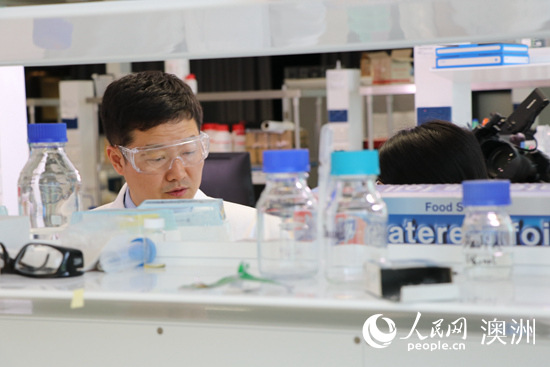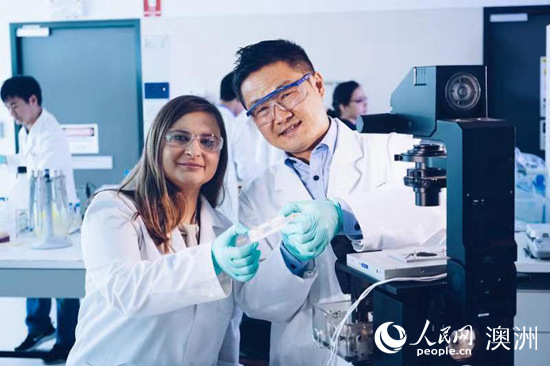

 |
Professor Dayong Jin is doing experiment in the laboratory (Photo by Lansudan Luo)
With the development of science and technology, diagnostic technologies have become more and more intelligent. Diabetics can easily detect blood sugar levels by using a small glucometer. Many smartphones also have the function to detect heart rate and heartbeat. This is also what the Institute for Biomedical Materials and Devices (IBMD) at the University of Technology Sydney has been focused on. The Director of this institute, Professor Dayong Jin won the 2017 Prime Minister’s Malcolm McIntosh Prize for Physical Scientist of the Year for his achievements in biomedical technologies and he is also the first Chinese scientist to win this prize.
Born in Liaoning, China, Jin in his childhood was just as naughty as many young boys. When he was in middle school, his parents got laid off, which gave him the inspiration to study harder. Like many Chinese students, he worked very hard for the college entrance examination during his three years in high school. “Even now sometimes I still have nightmares about an exam coming up but not being prepared." In university, Professor Jin was very keen on student association work and became the President of the Student Union. He was then recommended to study at the Shanghai Institute of Optics and Fine Mechanics, the Chinese Academy of Sciences for his master's degree.
The real research journey for Professor Jin started in 2003 when he studies his PhD degree at Macquarie University in Australia. “At that time, I didn't have my own lab. So in the beginning, I did research completely on my own, and picked up old instruments and built new ones by myself. Gradually, I found doing research is very interesting because I like exploring new things. I also learned independent thinking.”
Although the scientific research process is long and arduous, Professor Jin cannot hide his excitement when talking about his projects. He vividly illustrated his research with an example of google maps. “Google did a good job by using the satellite image and collecting all the images from different streets to build the street views. In this way, we can not only know the route but also get the real-time traffic condition,” he said, “In the field of biology, this is our dream. We want to build the street view inside of a cell by applying different techniques. Once we know that, you could have a much better understanding of the fundamental of diseases, and you could monitor and even predict the disease.”

A large-scale microscopes detecting equipment built by Professor Dayong Jin and his team (Photo by Qian Su)
Because of his research on this “Street View Inside Cell”, Professor Jin won the UNSW Eureka Prize for Excellence in Interdisciplinary Scientific Research, one of Australia’s most prestigious science award in 2015 and was listed as one of Australia's "Knowledge Nation 100" in 2016. In 2017, he won the Prime Minister’s Malcolm McIntosh Prize for Physical Scientist of the Year. Professor Jin told us that the current research only provides the possibility for the idea, and a lot of work is needed to follow up.
With all these prizes won, Professor Jin has received a lot of attention from people in different areas. During the interview, he expressed his hope that more Chinese scientists can contribute and win international awards. “It may seem strange at first to see someone like me with black hair getting this prize. In fact, winning this award means that the scientific research level of Chinese has been improved both in quantity and quality. Last year, Mr. Jian Yang, the winner of the Prime Minister’s Prize for Life Scientist of the Year is also a Chinese. I do believe that there will be more and more Chinese winners because it’s a consequent outcome for the improvement of the research ability of Chinese scientists.”
In recent years, Professor Jin has received more and more applications from Chinese students in his lab. “Now the number of Chinese students in my lab is increasing, thanks to China's attention on primary education and investment in education. The education I received in China in the early days has been laying a good foundation for my later scientific research process,” he said.

Professor Dayong Jin is introducing his research to People's Daily Online (Photo by Lansudan Luo)
“China now also attaches great importance to the investment in education. The laboratories and large facilities of various universities are funded by the state. Many students in my lab have received a scholarship from the China Scholarship Council to study in Australia. It is the support and investment in education at home that gives overseas students the opportunity to develop their abilities.”
Professor Jin's research project includes many interdisciplinary, international and industrial collaborative research. He believes that collaboration is a very important part of the scientific research process. Solving a problem always requires the cooperation of multiple disciplines and technologies and the cooperation may also promote better friendship between China and Australia.
“I have worked with Professor Peng Xi from Peking University for seven years on Super-resolution, and he has been an old friend with me for almost 11 years. We also have cooperation with Changchun Institute of Applied Chemistry Chinese Academy of Sciences and Dalian University of Technology,” he told us, “True friendship requires more than just a drink or a shake of the hand. It is always maintained through working together. My field of study is biological medical equipment and solving human health problems is a common issue that our world is facing. By bringing together the best-skilled workers in the world, we can really enhance the cooperation and friendship between all the countries.”

Professor Dayong Jin is doing research in the laboratory (Photo by Qian Su)
With the rapid development of the economy in China, Chinese scientific research has been developing at a remarkable speed in recent years. Professor Jin said he was often quite shocked by the level of progress. “In recent years, I always feel a little behind the pace of development every time I go back. The field of materials science, optics and engineering have developed rapidly. The rapid development of science and technology in China in recent years has made companies like Huawei and Tencent a direct beneficiary of high technology”.
“The reform and opening-up policy promoted the development of a new China. Australia's development over the past 100 years was also attributed to the opening up policy, which brought in a large number of talents. Both China and Australia should step up more exchanges, enhance understanding between the two countries and promote common development.” (People’s Daily Online/ Lansudan Luo)

 Award-winning photos show poverty reduction achievements in NE China's Jilin province
Award-winning photos show poverty reduction achievements in NE China's Jilin province People dance to greet advent of New Year in Ameiqituo Town, Guizhou
People dance to greet advent of New Year in Ameiqituo Town, Guizhou Fire brigade in Shanghai holds group wedding
Fire brigade in Shanghai holds group wedding Tourists enjoy ice sculptures in Datan Town, north China
Tourists enjoy ice sculptures in Datan Town, north China Sunset scenery of Dayan Pagoda in Xi'an
Sunset scenery of Dayan Pagoda in Xi'an Tourists have fun at scenic spot in Nanlong Town, NW China
Tourists have fun at scenic spot in Nanlong Town, NW China Harbin attracts tourists by making best use of ice in winter
Harbin attracts tourists by making best use of ice in winter In pics: FIS Alpine Ski Women's World Cup Slalom
In pics: FIS Alpine Ski Women's World Cup Slalom Black-necked cranes rest at reservoir in Lhunzhub County, Lhasa
Black-necked cranes rest at reservoir in Lhunzhub County, Lhasa China's FAST telescope will be available to foreign scientists in April
China's FAST telescope will be available to foreign scientists in April